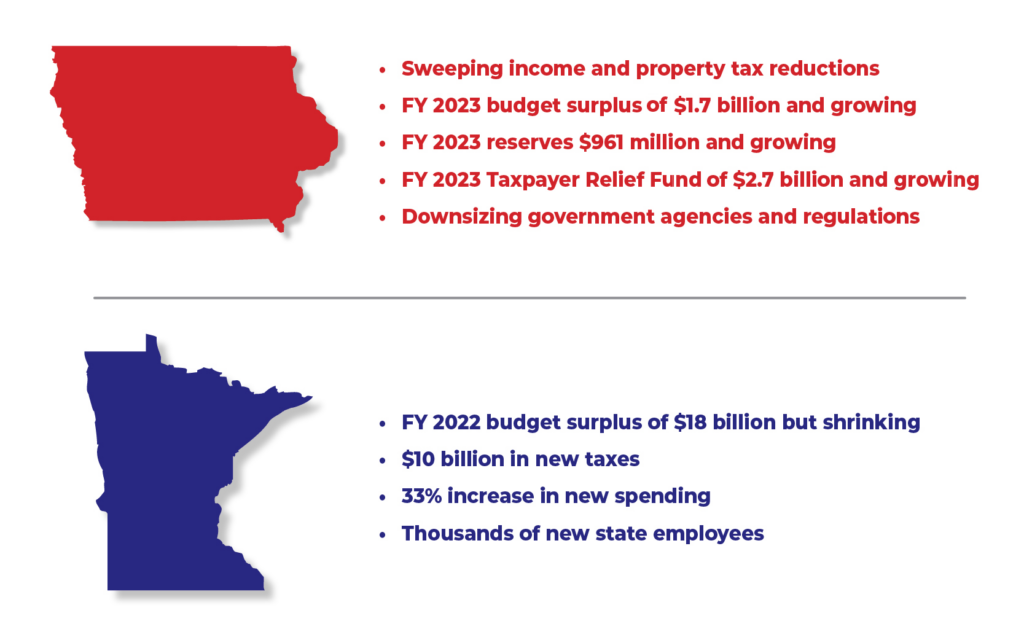This article was published in The Cedar Rapids Gazette.
Media outlets such as The Wall Street Journal are beginning to recognize that the Red-state model of limited spending and pro-growth tax reform is working.
A recent editorial by The Wall Street Journal highlights several progressive Democrat “Blue” states confronting budget problems as a result of overspending and tax increases. States such as New York, New Jersey, and California are experiencing declines in tax revenue, threatening their inflated budgets.
In New York, “state tax collections in the past two months are running 32.2 percent lower than a year ago,” the editorial explains, and the Empire State is projecting a $36.4 billion budget shortfall. A similar situation faces New Jersey, where revenue has declined 20 percent. Meanwhile, California’s budget deficit is estimated to be at least $32 billion. The reason these Blue states are experiencing budget deficits and declines in revenue is that they have followed the failed policy model of high spending and tax increases. Governments at any level cannot tax and spend their way to prosperity.
New York, New Jersey, and California are not the only progressive states in economic trouble. Illinois can be included on the list, and Minnesota recently ended its legislative session with a massive increase in spending. Minnesota began its latest legislative session with an $18 billion budget surplus, but the end result was not tax relief. Instead, the Minnesota legislature expanded government and created $10 billion in new taxes. State spending will increase by 33 percent.

The Wall Street Journal editorial offers Florida as “Red” comparison. In Florida, “tax revenue is exceeding forecasts,” and the editorial notes that corporate tax revenue is up 57.7 percent as a result of business expansion. Furthermore, Florida’s $117 billion budget is “half as large as New York’s, though it has 2.5 million more people.” Consequently, Florida has benefited from a mass exodus of people from the high-tax states now struggling for revenue.
Although Florida tends to be the lead example of fiscally conservative policies in the national media, Iowa is actually a better demonstration of their benefits. Governor Kim Reynolds and the Republican legislature have made conservative budgeting a priority. Even before the COVID pandemic, Iowa’s fiscal foundation was strong.
This session, the legislature enacted an $8.5 billion budget for fiscal year 2024 (FY24) that funds the priorities of government. The budget spends only 88.25 percent of projected tax collections, even though Iowa law permits up to 99 percent. The legislature, in short, has demonstrated fiscal restraint and controlled the growth of spending.
Indeed, Iowa’s budget continues to be in surplus. The surplus for FY23 is projected to be $1.7 billion, which is estimated to grow to $2 billion for FY24. Iowa’s reserve accounts (the Cash Reserve Fund and the Economic Emergency Fund) will continue to be funded at their statutory limits, holding a combined balance of over $961 million. Additionally, the Taxpayer Relief Fund will continue to increase; its balance for FY23 is $2.7 billion, which is estimated to increase to $3.5 billion in FY24.
Governor Reynolds and the legislature have also enacted a series of pro-growth policies. Last year, the legislature passed the largest income tax reform measure in state history. Iowa’s progressive income tax, which had nine rate brackets, will be replaced by a 3.9 percent flat tax by 2026.
Governor Reynolds also proposed, and the legislature passed, the first state government consolidation measure in over 40 years. This reform will consolidate agencies to increase government efficiency. Currently, Iowa has 37 executive-branch cabinet agencies — more than any of its neighbors. The new law will reduce the number of executive-level agencies to 16. This proposal is estimated to save taxpayers more than $214 million over four years.
Critics trying to preserve the Blue-state model argue policies such as those pursued by Governor Reynolds and the Iowa Legislature deprive various programs of much-needed resources, but reality doesn’t support these scare tactics. Even with conservative budgeting, government spending in Iowa continues to grow, and funding for programs such as public education continues to increase. The trick is that the critics call spending below their desired increase “a cut.”
As The Wall Street Journal editorial suggests, reality does support the Red-state model of fiscal conservatism founded in limited spending and pro-growth tax reform. The strategy is working across multiple states, and Iowa is setting the gold standard.
States cannot tax and spend their way to prosperity.
